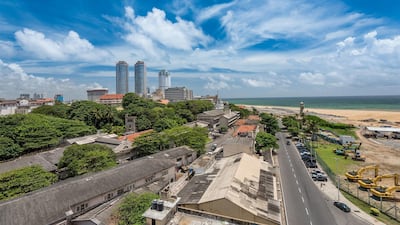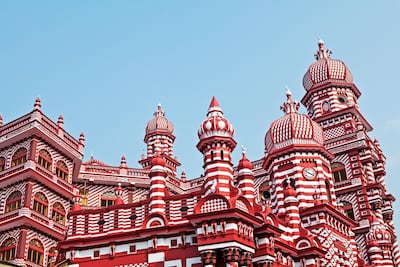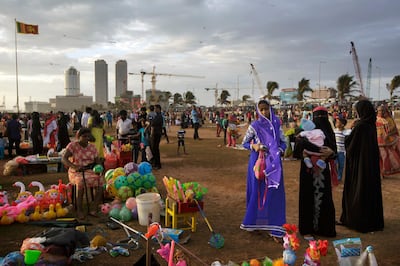Why Colombo?
This dynamic port city, which stretches along Sri Lanka’s Indian Ocean coast, has been ruled by the Portuguese, Dutch and British, and has emerged from a traumatic civil war, blossoming into an attractive base with colonial architecture, a cosmopolitan population and considerable charm.
Colombo is a mix of cultures and religions – its streets are lined with churches, Buddhist temples and mosques. It has a rich art scene with many galleries and markets, and plenty of green spaces with public parks and wide tree-lined boulevards. The city is also becoming a foodie destination, with restaurants and cafes serving both international fare and Sri Lankan specialities such as kothu parottas and hoppers.
In the past few years, the city has attracted tourists to its popular Colombo Jazz Festival, held each February. Urban renewal in the city has also created attractive spaces such as the Dutch Hospital, with a 400-year-old hospital converted into a shopping and eating complex, and the warehouses of Park Street Mews have been converted into a shopping and restaurant hub.
A comfortable bed
For a boutique experience stay at Tintagel – a unique, private hotel housed in a 1930s colonial building, with glitzy chandeliers and antique cabinets, and a mere 10 chic and stylish suites, in the heart of Colombo's District 7. Double rooms cost from about Dh620 per night.
The Cinnamon Grand Hotel is a typical luxurious five-star hotel with more than a dozen restaurants serving Indian and Sri Lankan food and a great location in the heart of the city. The large, sleek rooms come with great views of Colombo. Doubles cost from about per Dh340 per night.
The Movenpick is a smart city hotel with a central location and rooftop bar. The rooms are luxurious, with ocean views, and the hotel has an infinity pool, a spa and a pick of some great restaurants serving Indian, Chinese and Japanese food. Doubles cost from about Dh560 per night.
Find your feet
Explore the alleys and passages of the Fort Area – the former financial and commercial hub of the city that used to be enclosed by the Dutch ramparts, with a walking tour offered by local company Colombo City Walks led by local expert Mark Forbes. You can look at colonial architecture; see the oldest clock tower; walk through the chaotic Pettah Market, the haunt of the Arab traders, with its Ayurvedic medicine shops and shops selling gems and jewellery; glimpse beautiful red-and-white-striped mosque Jami-Ul-Alfar; and end with refreshments at the Grand Oriental Hotel. The tour costs US$50 (Dh184).
Walk through the Cinnamon Gardens neighborhood, which was once covered with cinnamon plantations and is now lined with the houses of the rich and famous, museums and the city’s biggest park. Head to tranquil Beira Lake with its floating temple, trees, and a prolific bird life. Visit the Buddhist Gangaramaya Temple – this bustling complex, with brightly painted statues and sculptures, also has a museum with a display of the gilded gifts presented by devotees. Entrance costs 100 Sri Lankan rupees (Dh2). Finish with a visit to the National Museum, Sri Lanka’s biggest cultural institution, which houses ancient bronzes, stone sculptures, colonial guns, dance masks and puppets. Entrance costs 500 rupees (Dh12).
Meet the locals
The Galle Face Green is a seaside lawn laid out by a British governor that serves as an open-air living room. This is where locals come to enjoy the sea breeze, play cricket and fly kites, and food trucks and carts sell deep-fried shrimp cakes. Mingle with the locals and take in the sea views. End the evening with a drink on the bar of the Galle Face Hotel, a colonial structure from 1864. Catch the Good Market held every Saturday at the racecourse grounds. The market has a variety of stalls selling organic produce, Ayurvedic products, garden supplies, home goods, books and handicrafts.
Book a table
Have a typical Sri Lankan meal at Upali's by Nwaloka. Try its set lunch menu, which costs 370 rupees (Dh9) and offers two types of rice, three vegetables, coconut sambol, papadams, fish and curried gravy.
The relatively pricey Ministry of Crab, in the Dutch Hospital Complex, belongs to former Sri Lankan cricketers Mahela Jayawardene and Kumar Sangakkara, and serves the freshest crabs in garlic, chilli, butter and pepper variations. A meal for two costs about 10,000 rupees (Dh230).
Try lamprais, a typical dish of the Burgher community – with boiled eggs, eggplant, mixed meats and rice all wrapped in a banana leaf and baked in the oven at a low temperature for several hours at the Dutch Burgher Union Cafe.
And head to the Park Street Mews Restaurant, which offers continental and tropical cuisine with good vegetarian options, too, from Vietnamese paper rolls to macaroni pasta with eggplant.
Shoppers’ paradise
Paradise Road, an acclaimed home-goods store, sells carefully curated handicrafts, stationery and lovely crockery with the Sinhala script.
The Dutch Hospital Complex is home to some fabulous shops, including Barefoot, which is famous for its colourful cotton textiles, sarongs, books and stuffed toys. If you want to pick up Sri Lankan souvenirs such as tea, ceramics, masks, gems and jewellery, head to the state-owned Laksala.
Dilly and Carlo (Sir Ernest de Silva Mawatha) is a local clothing brand that makes stylish clothes for men and women – especially batik. Odel is Sri Lanka's first department store, with unique garments and homewares.
Don’t miss
Drive out to Mount Lavinia outside the city for beach ambience, with stalls selling seafood. The colonial Mount Lavinia Hotel, housed in an 1806 mansion, serves a fantastic high tea. For a unique Sri Lankan experience, check out the T-Lounge by Dilmah at Independence Arcade, that serves different teas, cocktails, mocktails and tea-inspired burgers, subs and
even desserts.
What to avoid
Colombo is hot and humid for most of the year. Don’t forget to carry sunscreen and hydrate with bottled water and local coconut varieties. Avoid taking tuk tuks – their drivers can fleece you because most of their vehicles are not metered.
Getting there
Etihad and Emirates both fly direct from the UAE to Colombo, from Dh1,245 return, including taxes.
______________
Read more:
Hotel Insider: Shangri-La Hambantota
Hotel Insider: Anantara Peace Haven Resort & Spa Tangalle
Hotel Insider: Cape Weligama, Sri Lanka
______________



